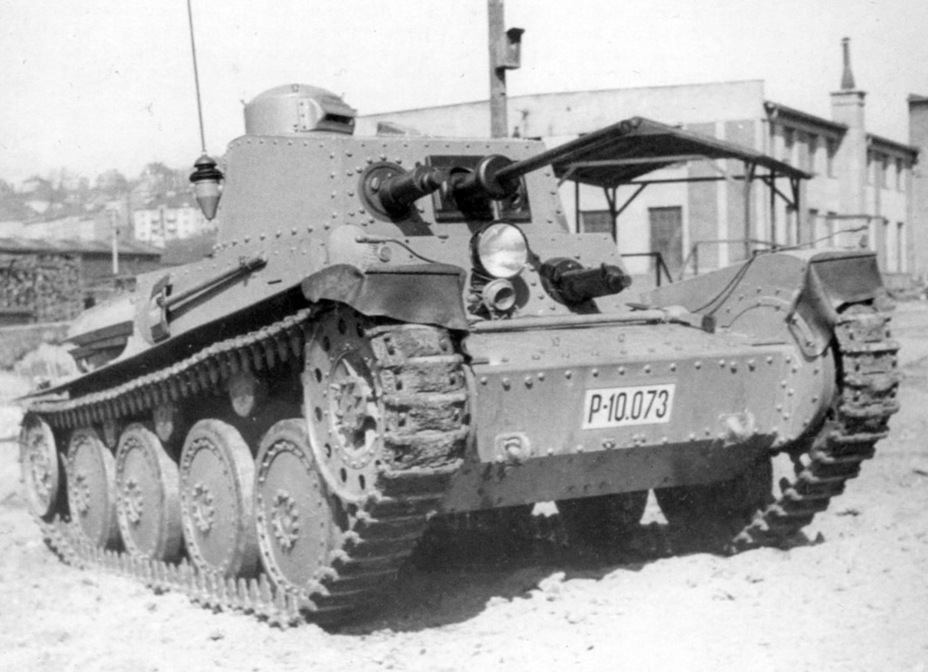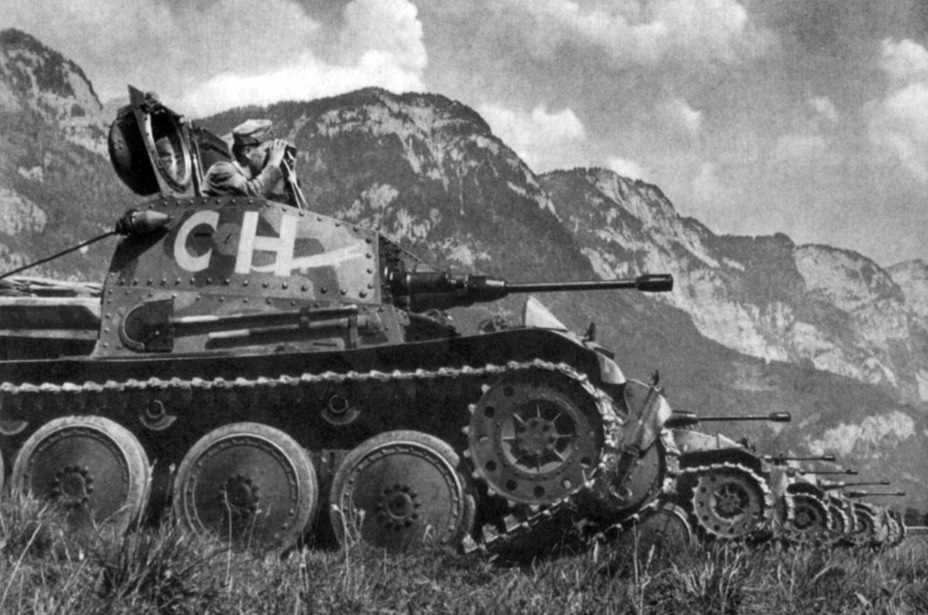- Yes, as a tech tree vehicle
- Yes, as a premium vehicle
- Yes, as an event vehicle
- Yes, as a squadron vehicle
- No, I would not like to see the Pzw 39 in game.
A Swiss Pzw 39 on parade. Switzerland has maintained their tanks well, and over one third have survived to today, with at least three (like above) in running order.
History
Despite being employed exclusively by Switzerland, the Panzerwagen 39 (Pzw 39) was originally a product of ČKD, a Czech engineering firm established in interwar Europe. In 1935, Switzerland, with an armored inventory mainly consisting of Renault FTs (a WW1 design!) and Vickers Model 1934 tanks, could read the writing on the wall and saw that they would need to upgrade their tanks if they wanted to stand a chance in armored combat against potential aggressors. The Swiss decided it would be best to shop around and took a look at German and Swedish designs, but they weren’t really satisfied with them. However, they had one more company in their contact book: ČKD, from whom Sweden was procuring some tankettes. ČKD offered their tankettes, which Switzerland turned down, along with their latest light tank model, which was more appetizing.
LTL-H on trials. It proved rather satisfactory, but required a few more revisions before the Swiss were willing to accept it.
The Praga LTL-H (also known simply as the LTH) was an adaptation of the built-to-order LTL designed for Lithuania. Originally, the Swiss asked for a 20mm Oerlikon cannon to be mounted. Later on, they figured it would probably be too weak for the anti-armor role, so the Swiss used the (also domestic designed) 24mm Pzw Kan 38 instead. The Kan 38 offered good rate of fire and ballistics, and despite being designed to arm tanks, would later be produced as an anti-tank rifle. There were some concerns during the Czech mobilization in 1938, but all 12 tanks that Switzerland had ordered were successfully delivered, and the type was ready for service as the Pzw 39. With 12 more tanks being built locally, Switzerland had 24 machines in their arsenal.
A line of Pzw 39s in the mountains. Early in their service life, a large “CH” insignia was added so it was perfectly clear which country these tanks belonged to.
The Pzw 39, of course, would never end up seeing combat, as Switzerland was a neutral nation and maintained their neutrality throughout World War II. While you might scoff at this tanks light armor and armament, it would likely have been quite formidable in the defensive war that Switzerland would have fought. The National Redoubt that Switzerland had constructed would be their main battleground. High in the mountains, the only vehicles that could reach this area would be automobiles, half-tracks, or other light tanks. In that sense, the 24mm cannon was completely adequate. The Pzw 39 also had excellent off-road capabilities and was very reliable. The Nazi Operation Tannenbaum, a joint invasion of Switzerland by Nazi Germany and Fascist Italy, came dangerously close to happening, and the Swiss tanks may have found themselves outmatched then. Thankfully, this never occured. The Pzw 39s were kept around until finally being retired in 1960, with a service life of over 20 years.
Design
The Pzw 39 was quite similar to the LT vz. 38 (Pz.Kpfw 38(t)). It weighed 7.7 tons with riveted armor plate up to 32mm thick in the front and was powered by a 120 hp Saurer CT1D diesel engine or 120 hp Scania Vabis 1664 petrol engine, thus giving it a power to weight ratio of 15.54 hp/t. It used the same four-wheel leaf-spring suspension as the Pz.38(t) and like the early model Pz.38(t) had three crew members: a driver, commander, and gunner. The turret was the main difference between the models. It mounted a 24mm Pzw Kan 38 with a distinct large muzzle brake alongside a coaxial 7.5mm Pzw Mg 38. There was another Pzw Mg 38 in the hull (strangely, also operated by the gunner), and the commander had access to a roof-mounted 7.5mm Lmg 25 machine gun. The 24mm cannon was top-loaded, magazine-fed and semi-automatic with a cyclic rate of 30-40 rounds/min. and could use armor piercing or high explosive shells. Uniquely, the armor piercing magazines were larger and contained 6 shells while the high explosive only contained 5 for ease of identification. The oil-cooled Pzw Mg 38 had a very high rate of fire: 1,200 rounds/min, while the Lmg 25 had a tamer 500 rounds/min fire rate. The Pzw 39 uniquely had an anti-molotov shield installed above the engine deck, though this is probably irrelevant for game purposes.
A Pzw Kan 38 in its natural habitat. The top loading magazine required a spring-loaded roof plate for when the gun was at maximum depression (below). The feed system was changed to side loading for the later anti-tank rifle version.
Specifications
Panzerwagen 39 (Praga LTL-H)
Crew : 3
Weight: 7.7 metric tons
Powerplant:
- Scania Vabis 1664 petrol engine (120 hp)
- Saurer CT1D diesel engine (120 hp)
Power to weight ratio: 15.54 hp/t
Maximum speed: 45 km/h
Armament:
- Main gun: 24mm Pzw Kan 38 (114 rounds)
- Cyclic rate: 30-40 rounds/min*
- Traverse: 360 degrees range
- Elevation: + 20 / - 10, hand cranked
- Ammunition types: AP-T, APHE-T**, HE-T
- Muzzle velocity (all): 900 m/s
- Coaxial machine gun: 7.5mm Pzw Mg 38 (2,500 rounds)
- Rate of fire: 1,200 rounds/min
- Bow machine gun: 7.5mm Pzw Mg 38 (2,500 rounds)
- Commander’s machine gun: 7.5mm Lmg 25 (300 rounds)
- Rate of fire: 500 rounds/min
Armor: 8 - 32 mm
Additional equipment: N/A
Number produced: 24
Notes:
- The cyclic rate of the gun is higher than the true rate of fire, as the loader would have to take time to switch magazines. This would likely be a fast process as the magazine is automatically ejected when empty.
** - APHE-T is not listed as a service munition in the source I consulted, but there is a drawing of said shell in the same general group of information - see the Cartridge Collectors’ forum link in the Sources section.
Conclusion
I believe the Pzw 39 would be an excellent addition to the reserve tier of War Thunder. This tank is uniquely Swiss and based off of Czech developments, so I believe adding it to any nation we currently have in the game would not be respectful to the Swiss and would not represent this vehicle’s technological roots accurately. Therefore I recommend this vehicle as a reserve option for a future Swiss tech tree, perhaps alongside the 20mm Oerlikon armed prototype described briefly earlier.
Pros:
- Magazine-fed 24mm cannon has a higher rate of fire than even the fastest manually loaded 37mm or 45mm cannons found on most reserve tanks.
- Very good muzzle velocity - shots at range would be easy to land
- Retains velocity well, penetration dropoff not too severe
- Good mobility and off-road characteristics
- 32mm frontal armor would protect from weak autocannons and even 20mm HVAP at range
- Coaxial and hull machine guns have a high rate of fire for engaging exposed crew
- Ammunition bank takes up very little space - hard to ammo rack.
Cons:
- Post-penetration damage would be lacking compared to 37mm or 45mm armed contemporaries
- Mediocre penetration: 50mm point blank if being generous, as well as weak explosive shells with only 8.4g filler
- Semi-automatic 24mm cannon has poor rate of fire compared to even the slowest 20mm autocannon, while caliber is only slightly improved.
- Armor would not be able to withstand cannon fire
- 3 crew densely packed - APHE hit likely to one-shot.
- The AA machine gun is magazine fed with a low rate of fire, unlikely to be too useful for its intended purpose
Sources:
- Autocannon: A History of Automatic Cannon and Their Ammunition by Anthony G. Williams (2022)
- Panzer 38(t)/Swiss LTL-H: Walk Around Color Series by Hans Heiri-Stapfer (2009)
- Praga LTH – Wikipedie
- Panzerwagen 39 Typ LTL-H, Pzw 39 mit Dieselmotor - Kampfpanzer - Raupenfahrzeuge | militärfahrzeuge.ch
- Swiss 24x139mm ammunition examples - General Ammunition Discussion - International Ammunition Association Web Forum
- Tank Archives: Praga LTL and Pzw 39: Tanks for Neutrals
- Panzer 39 - Tank Encyclopedia




